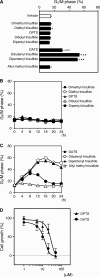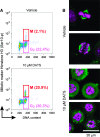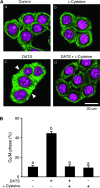Alkenyl group is responsible for the disruption of microtubule network formation in human colon cancer cell line HT-29 cells
- PMID: 18515280
- PMCID: PMC2500214
- DOI: 10.1093/carcin/bgn124
Alkenyl group is responsible for the disruption of microtubule network formation in human colon cancer cell line HT-29 cells
Abstract
Alk(en)yl trisulfides (R-SSS-R') are organosulfur compounds produced by crushed garlic and other Allium vegetables. We found that these compounds exhibit potent anticancer effects through the reaction with microtubules, causing cell cycle arrest. Nine alk(en)yl trisulfides including dimethyl trisulfide, diethyl trisulfide, dipropyl trisulfide (DPTS), dibutyl trisulfide, dipentyl trisulfide, diallyl trisulfide (DATS), dibutenyl trisulfide, dipentenyl trisulfide and allyl methyl trisulfide were synthesized and added to cultures of HT-29 human colon cancer cells at a concentration of 10 muM. The trisulfides with alkenyl groups such as DATS, but not those with alkyl groups, induced rapid microtubule disassembly at 30-60 min as well as cell cycle arrest during the mitotic phase approximately at 4 h after the treatment. Both DATS-induced microtubule disassembly and the cell cycle arrest were cancelled by the simultaneous treatment of the cancer cells with 2 mM L-cysteine, glutathione (GSH) or N-acetyl-L-cysteine. Reciprocally, L-buthionine-(S,R)-sulfoximine (500 muM), an inhibitor of GSH synthesis, enhanced the power of DATS in inducing the cell cycle arrest. These results indicate that alk(en)yl trisulfide react with sulfhydryl groups in cysteine residues of cellular proteins such as microtubule proteins. Thus, the present study provides evidence that trisulfides with alkenyl groups have potent anticancer activities, at least in part, directed toward microtubules. These findings suggest that alkenyl trisulfides and their structurally related compounds may provide novel and effective anticancer agents.
Figures






Similar articles
-
Relationship between lipophilicity and inhibitory activity against cancer cell growth of nine kinds of alk(en)yl trisulfides with different side chains.Oncol Res. 2010;18(11-12):575-82. doi: 10.3727/096504010x12767359113965. Oncol Res. 2010. PMID: 20939433
-
Anticancer effects of diallyl trisulfide derived from garlic.Asia Pac J Clin Nutr. 2008;17 Suppl 1:249-52. Asia Pac J Clin Nutr. 2008. PMID: 18296348 Review.
-
Diallyl trisulfide suppresses the proliferation and induces apoptosis of human colon cancer cells through oxidative modification of beta-tubulin.J Biol Chem. 2005 Dec 16;280(50):41487-93. doi: 10.1074/jbc.M507127200. Epub 2005 Oct 11. J Biol Chem. 2005. PMID: 16219763
-
Diallyl trisulfide protects rats from carbon tetrachloride-induced liver injury.J Nutr. 2009 Dec;139(12):2252-6. doi: 10.3945/jn.109.109611. Epub 2009 Oct 7. J Nutr. 2009. PMID: 19812219
-
Multitargeted prevention and therapy of cancer by diallyl trisulfide and related Allium vegetable-derived organosulfur compounds.Cancer Lett. 2008 Oct 8;269(2):305-14. doi: 10.1016/j.canlet.2008.05.027. Epub 2008 Jun 24. Cancer Lett. 2008. PMID: 18579286 Free PMC article. Review.
Cited by
-
Garlic oil suppresses high-fat diet induced obesity in rats through the upregulation of UCP-1 and the enhancement of energy expenditure.Exp Ther Med. 2020 Feb;19(2):1536-1540. doi: 10.3892/etm.2019.8386. Epub 2019 Dec 27. Exp Ther Med. 2020. PMID: 32010335 Free PMC article.
-
Selenium and Sulfur to Produce Allium Functional Crops.Molecules. 2017 Mar 30;22(4):558. doi: 10.3390/molecules22040558. Molecules. 2017. PMID: 28358332 Free PMC article. Review.
-
Tau dephosphorylation and microfilaments disruption are upstream events of the anti-proliferative effects of DADS in SH-SY5Y cells.J Cell Mol Med. 2010 Mar;14(3):564-77. doi: 10.1111/j.1582-4934.2008.00588.x. Epub 2008 Nov 14. J Cell Mol Med. 2010. PMID: 19040422 Free PMC article.
-
Hydrogen sulfide in biochemistry and medicine.Antioxid Redox Signal. 2012 Jul 1;17(1):119-40. doi: 10.1089/ars.2012.4612. Epub 2012 Apr 20. Antioxid Redox Signal. 2012. PMID: 22432697 Free PMC article. Review.
-
Dietary Bioactive Diallyl Trisulfide in Cancer Prevention and Treatment.Int J Mol Sci. 2017 Jul 28;18(8):1645. doi: 10.3390/ijms18081645. Int J Mol Sci. 2017. PMID: 28788092 Free PMC article. Review.
References
-
- Ross SA, et al. Allyl sulfur compounds from garlic modulate aberrant crypt formation. J. Nutr. 2006;136:852S–854S. - PubMed
-
- Sakamoto K, et al. Allyl sulfides from garlic suppress the in vitro proliferation of human A549 lung tumor cells. Nutr. Cancer. 1997;29:152–156. - PubMed
-
- Filomeni G, et al. Reactive oxygen species-dependent c-Jun NH2-terminal kinase/c-Jun signaling cascade mediates neuroblastoma cell death induced by diallyl disulfide. Cancer Res. 2003;63:5940–5949. - PubMed
-
- Xiao D, et al. Induction of apoptosis by the garlic-derived compound S-allylmercaptocysteine (SAMC) is associated with microtubule depolymerization and c-Jun NH2-terminal kinase 1 activation. Cancer Res. 2003;63:6825–6837. - PubMed
-
- Xiao D, et al. Diallyl trisulfide-induced apoptosis in human prostate cancer cells involves c-Jun N-terminal kinase and extracellular-signal regulated kinase-mediated phosphorylation of Bcl-2. Oncogene. 2004;23:5594–5606. - PubMed
Publication types
MeSH terms
Substances
LinkOut - more resources
Full Text Sources
Research Materials

